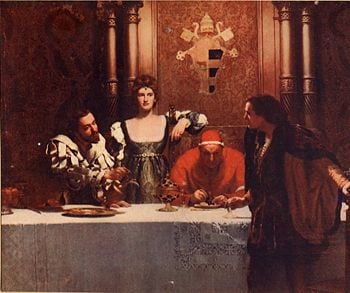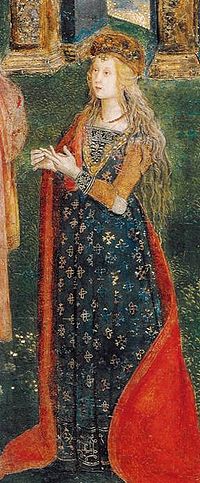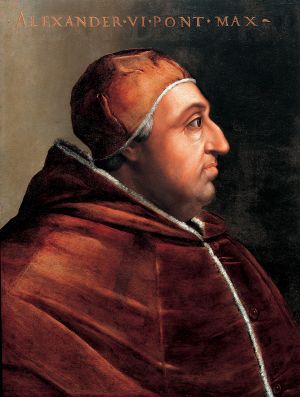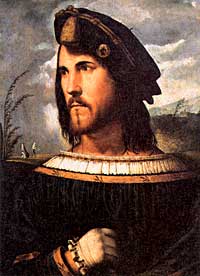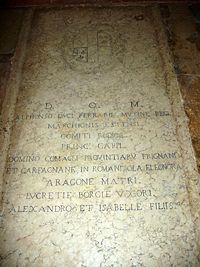Borgia, Lucrezia
(claimed) |
Rosie Tanabe (talk | contribs) |
||
| (42 intermediate revisions by 9 users not shown) | |||
| Line 1: | Line 1: | ||
| − | {{ | + | {{Images OK}}{{submitted}}{{approved}}{{Paid}}{{Copyedited}} |
| − | {{ | + | {{epname|Borgia, Lucrezia}} |
| − | + | [[Image:A Glass of Wine with Caesar Borgia - John Collier.jpg|thumb|350px|Not so holy family: Lucrezia Borgia with father Rodrigo (Pope Alexander VI) and brother Caesare. The figure in the foreground may be a depiction of the messenger Perotto. All three men were rumored to be the father of Lucrezia's first son.]] | |
| − | [[Image: | ||
| − | |||
| − | '''Lucrezia Borgia''' April 18, 1480 - June 24, 1519) was the daughter of [[Pope Alexander VI|Rodrigo Borgia]], the powerful [[Renaissance]] | + | '''Lucrezia Borgia''' (April 18, 1480 - June 24, 1519) was the daughter of [[Pope Alexander VI|Rodrigo Borgia]], the powerful [[Renaissance]] figure who later became Pope Alexander VI, and [[Vannozza dei Cattanei]]. Her brothers included [[Cesare Borgia]], [[Giovanni Borgia (1474)|Giovanni Borgia]], and [[Gioffre Borgia]]. She served for a time as ''de facto'' ruler of the [[Holy See]] during her father's absence and was infamous for her alleged involvement in various political and sexual intrigues. |
| − | Lucrezia's family | + | Lucrezia's family came to epitomize the ruthless [[Niccolò Machiavelli|Machiavellian]] politics and sexual corruption alleged to be characteristic of the Renaissance Papacy. She reportedly bore her first child out of wedlock, and both her brother and her father were widely suspected to be the father. It was also rumored that Lucrezia possessed a hollow ring that she used frequently to [[poison]] drinks at the family's elaborate dinner-parties.<ref>[http://www.guardian.co.uk/Archive/Article/0,4273,4349740,00.html Renaissance villain given a makeover], ''www.guardian.co.uk'', [http://www.bbc.co.uk/dna/h2g2/A4350755 A Brief History of Poisoning], ''www.bbc.co.uk'', Retrieved November 14, 2007.</ref> |
| + | {{toc}} | ||
| + | Not enough is known about the historical Lucrezia to be certain whether any of the more notorious stories about her active involvement in her father's and brother's crimes are true. Her father and/or brother certainly arranged several marriages for her to important or powerful men in order to advance their own political ambitions and to augment the political and territorial power of the Borgias. Lucrezia was married to [[Giovanni Sforza]] (Lord of Pesaro), Alfonso of Aragon (Duke of [[Bisceglie]]), and [[Alphonso d'Este]] (Prince of [[Ferrara]]). | ||
| − | + | ==Biography== | |
| + | [[File:Lucretia Borgia Pinturicchio.jpg|thumb|right|200px|Lucrezia Borgia by Pinturicchio]] | ||
| + | In 1491, at the tender age of 13, Lucrezia was [[betrothed]] to two different Spanish nobles. However, by 1492, her father had become pope and both engagements had successively been called off. | ||
| − | + | ===First marriage=== | |
| + | After Rodrigo became [[Pope Alexander VI]], he decided that Lucrezia would marry [[Giovanni Sforza]], Lord of Pesaro, to establish an alliance with the powerful [[Milan|Milanese]] family. The wedding took place in 1493 and was considered a scandalous event by some because of its ostentation. In actuality, it was not much more extravagant than many other [[Renaissance]] celebrations. | ||
| − | + | Before long, it appears that the Borgia family no longer needed the [[Sforza]]s, and the presence of Giovanni Sforza in the papal court was considered superfluous. Pope Alexander allied himself with [[Naples]], while Milan was allied with the [[France|French]]. Both the Pope and the Milanese Sforza family sought out more advantageous political alliances. | |
| − | |||
| − | + | After a series of events—including Giovanni fearing for his life, fleeing from Rome, and charging paternal and fraternal [[incest]] by Lucrezia—Alexander asked Giovanni's uncle, Cardinal [[Ascanio Sforza]], to persuade Giovanni to agree to a divorce. Since the marriage had supposedly not been [[consummate|consummated]], the Pope declared that the marriage was not valid. He offered Giovanni all of Lucrezia's [[dowry]] to seal the agreement. The Sforza family threatened to withdraw their protection of Giovanni if he refused Alexander's offer. Having no choice, Giovanni Sforza signed both a confession of [[impotence]] and the documents of [[annulment]] before witnesses in 1497. | |
| − | + | ===The 'Infans Romanus'=== | |
| + | [[File:Pope Alexander Vi.jpg|thumb|left|Alexander VI, Lucrezia's father]] | ||
| + | During the prolonged process of the annulment, Lucrezia may have consummated a relationship with someone, either Alexander's messenger, Pedro Calderon, aka [[Perotto]] or—more infamously—Alexander himself, her own father. The result was that she was rumored to be pregnant when her marriage was annulled, despite it having never been consummated. That she even gave birth to a child remains a debated question. In any case, a child, named [[Giovanni Borgia (1498)|Giovanni]], but known to historians as the [[Roman Infante]] (Infans Romanus), was born in secret (1498) before Lucrezia's second marriage. Some believe that the child was her brother Cesare's, who at the time was a cardinal, but that Perotto, due to his fondness for Lucrezia, reportedly claimed that it was his. After the divorce, she stayed away from [[Rome]] at a convent, lending credence to the idea that she was attempting to hide her pregnancy; and Perotto would bring her messages from her father in [[Rome]]. | ||
| − | + | In 1501, two [[papal bull]]s were issued concerning Giovanni Borgia. In the first, he was recognized as Cesare's child from an affair before his marriage. The second bull recognized him as the son of Pope Alexander VI. Lucrezia's name is not mentioned in either, and rumors that she was his mother have never been proven. The second bull was kept a secret for many years, and Giovanni was presumed to be Cesare's son. This version is supported by the fact that in 1502, he became Duke of [[Camerino]], one of Cesare's recent conquests (amidst the backdrop of the [[Italian Wars]]), hence the natural inheritance of the Duke of [[Romagna]]'s oldest son. However, some time after Alexander's death, Giovanni went to stay with Lucrezia in Ferrara, where he was accepted as her half-brother. | |
| − | + | ===Alfonso of Aragon=== | |
| + | [[Image:Cesareborgia.jpg|thumb|Cesare Borgia]] | ||
| + | In order to strengthen ties with [[Naples]], Pope Alexander in 1498 arranged a marriage between Lucrezia and the 17-year-old Alfonso, duke of Bisceglie, an illegitimate son of Alfonso II of Naples. | ||
| − | + | However, after Cesare's alliance with the French king [[Louis XII]] (1499) and his subsequent campaign in the Duchy of Romagna, which threatened Naples, Alfonso fled Rome, returning with Lucrezia in October. While visiting Lucrezia's family in July 1500, he was wounded by four would-be assassins on the steps of [[St. Peter's Basilica]]. While recovering, he was reportedly strangled by one of Cesare's servants. The murder provoked the desired rupture with Naples. Lucrezia and Alfonso of Aragon had only one child, Rodrigo, who was destined to die before his mother, in August 1512 at the age of 12. | |
| − | + | Around the same time, Alexander took the opportunity, with the help of the powerful [[Orsini]] (family), to force the rival [[Colonna]] family to obedience; leaving Lucrezia in charge of the [[Holy See]] as his representative or regent. This worked to give Lucrezia the air of political stature while Alexander concurrently worked to secure Lucrezia's marriage to her next husband. | |
| − | + | ===Alphonso d'Este and the Fall of the Borgias=== | |
| + | Lucretia's third marriage helped consolidate her brother Cesare's position in the Romagna by opening the road to [[Tuscany]], an important trade route of the day. This third marriage, to Alphonso [[d'Este]] (Prince of Ferrara), proved to be a lasting one, and she bore him six children. | ||
| − | + | The fall of the power of the Borgias followed with her father's death in 1503 despite Cesare's immense capabilities. Cesare, gravely ill, was planning the conquest of Tuscany, but could do nothing without continued papal patronage. The new pope, [[Pius III]], supported him, but his reign was short and was followed with the accession of the Borgias' deadly enemy, [[Julius II]]. | |
| − | + | While moving to Romagna to quell a revolt, Cesare was seized and imprisoned near Perugia. All Borgia lands were subsequently acquired by the [[Papal States]]. After exile to [[Spain]], in 1504, followed by imprisonment and escape, Cesare joined his brother-in-law, [[King John III]] of Navarre; dying in his service during a military campaign in 1507. | |
| − | + | Meanwhile, Lucrezia, no longer needing to play a major political role at the court of Ferrara—which became a center for the arts and letters of the [[Italy|Italian]] [[Renaissance]]—was able to live a more normal life and turned to religion in her final years. She died on June 24, 1519 at the age of 39, due to complications occurring during the birth of her eighth child. | |
| − | |||
| − | |||
| − | |||
| − | |||
| − | |||
| − | |||
| − | |||
| − | |||
| + | ==Children== | ||
| + | [[Image:Grave of Duke Alfonso I d'Este, Lucretia Borgia, etc. - Ferrara, Italy.JPG|200px|thumb|right|Tomb of [[Alfonso I d'Este]] and Lucrezia Borgia, [[Ferrara]]]] | ||
Lucrezia was mother to eight children: | Lucrezia was mother to eight children: | ||
| − | *[[Giovanni Borgia (1498)|Giovanni Borgia]], "infans Romanus" ("Child of [[Rome]]," c. 1498 - 1548). Paternity acknowledged by Perotto; however Alexander and Cesare have also been identified as the father | + | *[[Giovanni Borgia (1498)|Giovanni Borgia]], the "infans Romanus" ("Child of [[Rome]]," c. 1498 - 1548). Paternity acknowledged by Perotto; however Alexander and Cesare have also been identified as the father |
* Rodrigo Borgia of Aragon (November 1, 1499 - August, 1512). Son by Alfonso of Aragon. | * Rodrigo Borgia of Aragon (November 1, 1499 - August, 1512). Son by Alfonso of Aragon. | ||
* [[Ercole II d'Este]], [[List of Dukes of Ferrara and of Modena|Duke of Ferrara]] (April 5, 1508 - October 3, 1559). | * [[Ercole II d'Este]], [[List of Dukes of Ferrara and of Modena|Duke of Ferrara]] (April 5, 1508 - October 3, 1559). | ||
| Line 53: | Line 54: | ||
* Leonora d'Este (July 3, 1515 - July 15, 1575). A [[nun]]. | * Leonora d'Este (July 3, 1515 - July 15, 1575). A [[nun]]. | ||
* Francesco d'Este, Marchese di Massalombarda (November 1, 1516 - February 2, 1578). | * Francesco d'Este, Marchese di Massalombarda (November 1, 1516 - February 2, 1578). | ||
| − | *Isabella Maria d'Este (Born and deceased on June 14, 1519) | + | *Isabella Maria d'Este (Born and deceased on June 14, 1519). |
| − | == | + | ==Legacy== |
| − | + | The various stories surrounding the life of Lucrezia Borgia have made her a virtual icon for corruption and death within the halls of power, particularly, within the Roman [[Catholic Church]]. Rumors and exaggeration over time have only added to such. | |
| − | + | It should be noted that Lucrezia, in those the years after the death of her father and in the ensuing years with her third husband, found her religion at last and lived out her live as a wife, mother, and Christian woman. Her legacy is perhaps, therefore, that in all life there is the hope of ultimate (and eternal) redemption if one is but willing to seek it. | |
| − | |||
| − | |||
| − | |||
| − | |||
| − | == | + | ==Her Story in Film == |
| − | *''Lucrezia Borgia | + | * ''[[Lucrezia Borgia (1926 movie)|Lucrezia Borgia]]'' (1922) a [[silent movie]] with [[Liane Haid]], directed by [[Richard Oswald]] |
| − | *''Lucrezia Borgia | + | * ''[[Don Juan (1926 film)|Don Juan]]'' (1926), one of the first [[Vitaphone]]/Silent films starring [[John Barrymore]] features the Borgia as villains |
| − | * [ | + | * ''Lucrèce Borgia'' (1935), a French film version with [[Edwige Feuillère]], directed by [[Abel Gance]] |
| − | * '' | + | * ''Lucrezia Borgia'' (1940), an Italian film with Isa Pola, directed by Hans Hinrich |
| + | * ''Bride of Vengeance'' or ''A Mask for Lucretia'' (1949) starred [[Paulette Goddard]] as Lucretia (and [[Macdonald Carey]] as Cesare) | ||
| + | * ''Lucrèce Borgia'' (1953), a French movie with [[Martine Carol]], directed by [[Christian-Jaque]] | ||
| + | * ''[[Le Notti segrete di Lucrezia Borgia]]'' (1982), a Spanish-Italian film with Finnish actress [[Sirpa Lane]] as Lucrezia, directed by [[Roberto Bianchi Montero]]. | ||
| + | * ''[[Los Borgia]]'' (2006), a Spanish-Italian film with [[María Valverde]] as Lucrezia | ||
| − | + | ==Notes== | |
| + | <references/> | ||
| − | == | + | == References == |
| − | + | * Bradford, Sarah. ''Lucrezia Borgia - Life, Love And Death In Renaissance Italy''. Penguin, 2005. ISBN 9780143035954 | |
| − | + | * Cloulas, Ivan. ''The Borgias''. Franklin Watts, 1989. ISBN 9780531151013 | |
| − | * | + | * Erlanger, Rachel. ''Lucrezia Borgia: A Biography''. Dutton Adult, 1985. ISBN 9780801547256 |
| − | + | * Faunce, John. ''Lucrezia Borgia: A Novel''. Three Rivers Press, 2004. ISBN 9781400051229 | |
| − | + | * Mallett, Michael Edward. ''The Borgias: The Rise and Fall of a Renaissance Dynasty''. Academy Chicago Publishers, 1987. ISBN 9780897332385 | |
| − | |||
| − | |||
| − | * '' | ||
| − | * | ||
| − | |||
| − | |||
| − | |||
| − | * | ||
| − | |||
| − | |||
| − | |||
| − | == | + | ==External Links== |
| + | All links retrieved November 4, 2022. | ||
| − | * | + | *[http://www.musicwithease.com/lucrezia-borgia-synopsis.html Lucrezia Borgia] – An Opera by Gaetano Donizetti |
| − | + | *[https://www.thoughtco.com/lucrezia-borgia-bio-3529703 Biography of Lucrezia Borgia] – ''ThoughtCo.'' | |
| − | + | *[http://www..newadvent.org/cathen/01289a.htm Pope Alexander VI] – ''Catholic Encyclopedia''. | |
| − | |||
| − | |||
| − | |||
| − | |||
| − | * [ | ||
| − | |||
| − | |||
| − | |||
| − | |||
| − | |||
| − | * | ||
| − | |||
| − | |||
| − | |||
| − | [[Category: | + | [[Category:biography]] |
| − | {{Credit| | + | {{Credit|132181927}} |
Latest revision as of 02:28, 5 November 2022
Lucrezia Borgia (April 18, 1480 - June 24, 1519) was the daughter of Rodrigo Borgia, the powerful Renaissance figure who later became Pope Alexander VI, and Vannozza dei Cattanei. Her brothers included Cesare Borgia, Giovanni Borgia, and Gioffre Borgia. She served for a time as de facto ruler of the Holy See during her father's absence and was infamous for her alleged involvement in various political and sexual intrigues.
Lucrezia's family came to epitomize the ruthless Machiavellian politics and sexual corruption alleged to be characteristic of the Renaissance Papacy. She reportedly bore her first child out of wedlock, and both her brother and her father were widely suspected to be the father. It was also rumored that Lucrezia possessed a hollow ring that she used frequently to poison drinks at the family's elaborate dinner-parties.[1]
Not enough is known about the historical Lucrezia to be certain whether any of the more notorious stories about her active involvement in her father's and brother's crimes are true. Her father and/or brother certainly arranged several marriages for her to important or powerful men in order to advance their own political ambitions and to augment the political and territorial power of the Borgias. Lucrezia was married to Giovanni Sforza (Lord of Pesaro), Alfonso of Aragon (Duke of Bisceglie), and Alphonso d'Este (Prince of Ferrara).
Biography
In 1491, at the tender age of 13, Lucrezia was betrothed to two different Spanish nobles. However, by 1492, her father had become pope and both engagements had successively been called off.
First marriage
After Rodrigo became Pope Alexander VI, he decided that Lucrezia would marry Giovanni Sforza, Lord of Pesaro, to establish an alliance with the powerful Milanese family. The wedding took place in 1493 and was considered a scandalous event by some because of its ostentation. In actuality, it was not much more extravagant than many other Renaissance celebrations.
Before long, it appears that the Borgia family no longer needed the Sforzas, and the presence of Giovanni Sforza in the papal court was considered superfluous. Pope Alexander allied himself with Naples, while Milan was allied with the French. Both the Pope and the Milanese Sforza family sought out more advantageous political alliances.
After a series of events—including Giovanni fearing for his life, fleeing from Rome, and charging paternal and fraternal incest by Lucrezia—Alexander asked Giovanni's uncle, Cardinal Ascanio Sforza, to persuade Giovanni to agree to a divorce. Since the marriage had supposedly not been consummated, the Pope declared that the marriage was not valid. He offered Giovanni all of Lucrezia's dowry to seal the agreement. The Sforza family threatened to withdraw their protection of Giovanni if he refused Alexander's offer. Having no choice, Giovanni Sforza signed both a confession of impotence and the documents of annulment before witnesses in 1497.
The 'Infans Romanus'
During the prolonged process of the annulment, Lucrezia may have consummated a relationship with someone, either Alexander's messenger, Pedro Calderon, aka Perotto or—more infamously—Alexander himself, her own father. The result was that she was rumored to be pregnant when her marriage was annulled, despite it having never been consummated. That she even gave birth to a child remains a debated question. In any case, a child, named Giovanni, but known to historians as the Roman Infante (Infans Romanus), was born in secret (1498) before Lucrezia's second marriage. Some believe that the child was her brother Cesare's, who at the time was a cardinal, but that Perotto, due to his fondness for Lucrezia, reportedly claimed that it was his. After the divorce, she stayed away from Rome at a convent, lending credence to the idea that she was attempting to hide her pregnancy; and Perotto would bring her messages from her father in Rome.
In 1501, two papal bulls were issued concerning Giovanni Borgia. In the first, he was recognized as Cesare's child from an affair before his marriage. The second bull recognized him as the son of Pope Alexander VI. Lucrezia's name is not mentioned in either, and rumors that she was his mother have never been proven. The second bull was kept a secret for many years, and Giovanni was presumed to be Cesare's son. This version is supported by the fact that in 1502, he became Duke of Camerino, one of Cesare's recent conquests (amidst the backdrop of the Italian Wars), hence the natural inheritance of the Duke of Romagna's oldest son. However, some time after Alexander's death, Giovanni went to stay with Lucrezia in Ferrara, where he was accepted as her half-brother.
Alfonso of Aragon
In order to strengthen ties with Naples, Pope Alexander in 1498 arranged a marriage between Lucrezia and the 17-year-old Alfonso, duke of Bisceglie, an illegitimate son of Alfonso II of Naples.
However, after Cesare's alliance with the French king Louis XII (1499) and his subsequent campaign in the Duchy of Romagna, which threatened Naples, Alfonso fled Rome, returning with Lucrezia in October. While visiting Lucrezia's family in July 1500, he was wounded by four would-be assassins on the steps of St. Peter's Basilica. While recovering, he was reportedly strangled by one of Cesare's servants. The murder provoked the desired rupture with Naples. Lucrezia and Alfonso of Aragon had only one child, Rodrigo, who was destined to die before his mother, in August 1512 at the age of 12.
Around the same time, Alexander took the opportunity, with the help of the powerful Orsini (family), to force the rival Colonna family to obedience; leaving Lucrezia in charge of the Holy See as his representative or regent. This worked to give Lucrezia the air of political stature while Alexander concurrently worked to secure Lucrezia's marriage to her next husband.
Alphonso d'Este and the Fall of the Borgias
Lucretia's third marriage helped consolidate her brother Cesare's position in the Romagna by opening the road to Tuscany, an important trade route of the day. This third marriage, to Alphonso d'Este (Prince of Ferrara), proved to be a lasting one, and she bore him six children.
The fall of the power of the Borgias followed with her father's death in 1503 despite Cesare's immense capabilities. Cesare, gravely ill, was planning the conquest of Tuscany, but could do nothing without continued papal patronage. The new pope, Pius III, supported him, but his reign was short and was followed with the accession of the Borgias' deadly enemy, Julius II.
While moving to Romagna to quell a revolt, Cesare was seized and imprisoned near Perugia. All Borgia lands were subsequently acquired by the Papal States. After exile to Spain, in 1504, followed by imprisonment and escape, Cesare joined his brother-in-law, King John III of Navarre; dying in his service during a military campaign in 1507.
Meanwhile, Lucrezia, no longer needing to play a major political role at the court of Ferrara—which became a center for the arts and letters of the Italian Renaissance—was able to live a more normal life and turned to religion in her final years. She died on June 24, 1519 at the age of 39, due to complications occurring during the birth of her eighth child.
Children
Lucrezia was mother to eight children:
- Giovanni Borgia, the "infans Romanus" ("Child of Rome," c. 1498 - 1548). Paternity acknowledged by Perotto; however Alexander and Cesare have also been identified as the father
- Rodrigo Borgia of Aragon (November 1, 1499 - August, 1512). Son by Alfonso of Aragon.
- Ercole II d'Este, Duke of Ferrara (April 5, 1508 - October 3, 1559).
- Ippolito II d'Este (August 25, 1509 - December 1, 1572). Archbishop of Milan and later Cardinal.
- Alessandro d'Este (1514 - 1516).
- Leonora d'Este (July 3, 1515 - July 15, 1575). A nun.
- Francesco d'Este, Marchese di Massalombarda (November 1, 1516 - February 2, 1578).
- Isabella Maria d'Este (Born and deceased on June 14, 1519).
Legacy
The various stories surrounding the life of Lucrezia Borgia have made her a virtual icon for corruption and death within the halls of power, particularly, within the Roman Catholic Church. Rumors and exaggeration over time have only added to such.
It should be noted that Lucrezia, in those the years after the death of her father and in the ensuing years with her third husband, found her religion at last and lived out her live as a wife, mother, and Christian woman. Her legacy is perhaps, therefore, that in all life there is the hope of ultimate (and eternal) redemption if one is but willing to seek it.
Her Story in Film
- Lucrezia Borgia (1922) a silent movie with Liane Haid, directed by Richard Oswald
- Don Juan (1926), one of the first Vitaphone/Silent films starring John Barrymore features the Borgia as villains
- Lucrèce Borgia (1935), a French film version with Edwige Feuillère, directed by Abel Gance
- Lucrezia Borgia (1940), an Italian film with Isa Pola, directed by Hans Hinrich
- Bride of Vengeance or A Mask for Lucretia (1949) starred Paulette Goddard as Lucretia (and Macdonald Carey as Cesare)
- Lucrèce Borgia (1953), a French movie with Martine Carol, directed by Christian-Jaque
- Le Notti segrete di Lucrezia Borgia (1982), a Spanish-Italian film with Finnish actress Sirpa Lane as Lucrezia, directed by Roberto Bianchi Montero.
- Los Borgia (2006), a Spanish-Italian film with María Valverde as Lucrezia
Notes
- ↑ Renaissance villain given a makeover, www.guardian.co.uk, A Brief History of Poisoning, www.bbc.co.uk, Retrieved November 14, 2007.
ReferencesISBN links support NWE through referral fees
- Bradford, Sarah. Lucrezia Borgia - Life, Love And Death In Renaissance Italy. Penguin, 2005. ISBN 9780143035954
- Cloulas, Ivan. The Borgias. Franklin Watts, 1989. ISBN 9780531151013
- Erlanger, Rachel. Lucrezia Borgia: A Biography. Dutton Adult, 1985. ISBN 9780801547256
- Faunce, John. Lucrezia Borgia: A Novel. Three Rivers Press, 2004. ISBN 9781400051229
- Mallett, Michael Edward. The Borgias: The Rise and Fall of a Renaissance Dynasty. Academy Chicago Publishers, 1987. ISBN 9780897332385
External Links
All links retrieved November 4, 2022.
- Lucrezia Borgia – An Opera by Gaetano Donizetti
- Biography of Lucrezia Borgia – ThoughtCo.
- Pope Alexander VI – Catholic Encyclopedia.
Credits
New World Encyclopedia writers and editors rewrote and completed the Wikipedia article in accordance with New World Encyclopedia standards. This article abides by terms of the Creative Commons CC-by-sa 3.0 License (CC-by-sa), which may be used and disseminated with proper attribution. Credit is due under the terms of this license that can reference both the New World Encyclopedia contributors and the selfless volunteer contributors of the Wikimedia Foundation. To cite this article click here for a list of acceptable citing formats.The history of earlier contributions by wikipedians is accessible to researchers here:
The history of this article since it was imported to New World Encyclopedia:
Note: Some restrictions may apply to use of individual images which are separately licensed.
